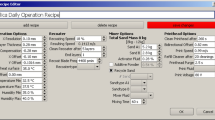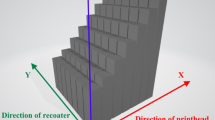Abstract
The development of sand mold three-dimensional printing technologies enables the manufacturing of molds without the use of a physical model. However, the effects of the three-dimensional printing process parameters on the mold permeability and strength are not well known, leading the industries to keep old settings until castings have recurring defects. In the present work, the influence of these parameters was experimentally investigated to understand their effect on the mold strength and permeability. Cylindrical and bar-shaped test specimens were printed to perform, respectively, permeability and bending strength measurements. Experiments were designed to statistically quantify the individual and combined effect of these process parameters. While the binder quantity only affects the mold strength, increasing the recoater speed leads to both greater permeability and reduced strength due to the reduced sand compaction. Recommendations for optimizing some 3D printer settings are proposed to attain predefined mold properties and minimize the anisotropic behavior of the sand mold in regard to both the orientation and the position in the job box.
Similar content being viewed by others
References
Dimitrov D, Schreve K, de Beer N, Chritiane P (2008) Three dimensional printing in the South African industrial environment. S Afr J Ind Eng 19:195–213
Sachs E, Cima M, Cornie J, Brancazio D (1990) Dimensional printing: rapid tooling and prototypes directly from CAD representation. Solid Free Fabr Symp 27–47. doi: 10.1016/S0007-8506(07)61035-X
Travitzky N, Bonet A, Dermeik B, Fey T, Filbert-Demut I, Schlier L et al (2014) Additive manufacturing of ceramic-based materials. Adv Eng Mater 16:729–754. doi:10.1002/adem.201400097
Singamneni S, Diegel O (2010) Some recent developments and experiences with rapid manufacturing by indirect means. Asian Int J Sci Technol Prod Manuf Eng 3:7–14
Snelling D, Williams CB, Druschitz AP (2014) A comparison of binder burnout and mechanical characteristics of printed and chemically Bonded sand molds. In: SFF Symp Austin TX 197–209
Stefanic I, Raos P, Samardzic I, Tintor B, Musser E (2012) Rapid prototyping of casting cores. Teh Vjesn Gaz 19:459–464
Budzik G (2007) Possibilities of utilizing 3DP technology for foundry mould making. Arch Foundry Eng 7:65–68
Drokina VV, Belov VD, Chekhonin SN (2011) Obtaining casts of aluminum alloys by foundry in loose molds fabricated on installations of three-dimensional printing. Russ J Non-Ferrous Met 52:24–28. doi:10.3103/S1067821211010081
Koltygin AV, Bazhenov VE (2012) Development of a substitute for Z cast molding sand used on installations of 3D printing for obtaining aluminum, magnesium, and iron casting. Russ J Non-Ferrous Met 53:38–41. doi:10.3103/S1067821212010129
Kumar R, Ahuja IPS, Singh R (2014) Experimental and analytical analysis of light alloy shell castings using three dimensional printing. International Journal of Advance Research and Innovation, 2(3):650–62
Gill SS, Kaplas M (2011) Efficacy of powder-based three-dimensional printing (3DP) technologies for rapid casting of light alloys. Int J Adv Manuf Technol 52:53–64
Bobby SS (2014) A preliminary investigation of gypsum bonded moulds by three dimensional printing. Int J Res Eng Technol, 3(06):501–7
Hościło B, Kaczyński R, Skorulski G (2014) Rapid prototyping technology using for casting process of mini turbine runner. Arch Foundry Eng 14:83–86
Snelling D, Li Q, Meisel N, Williams CB, Batra RC, Druschitz AP (2015) Lightweight metal cellular structures fabricated via 3D printing of sand cast molds. Adv Eng Mater 17:923–932. doi:10.1002/adem.201400524
Mckenna N, Singamneni S, Diegel O, Singh D, Neitzert T, George JS, et al. (2008) Direct metal casting through 3D printing: a critical analysis of the mould characteristics. In: 9th Glob Congr Manuf Manag (GCMM), Queensland, Australia: 12–4
Motoyama Y, Inoue Y, Saito G, Yoshida M (2013) A verification of the thermal stress analysis, including the furan sand mold, used to predict the thermal stress in castings. J Mater Process Technol 213:2270–2277. doi:10.1016/j.jmatprotec.2013.06.024
Motoyama Y, Takahashi H, Inoue Y, Shinji K, Yoshida M (2013) Dymanic measurements of the load on castings and the contraction of castings during cooling in sand molds. J Mater Process Technol 213:238–244
Nyembwe K, de Beer DJ, van der Walt JG, Bhero S (2012) Assessment of surface finish and dimensional accuracy of tools. South African J Ind Eng 23:130–143
Singh R (2009) Three dimensional printing for casting applications: a state of art review and future perspectives. Adv Mater Res 83–86:342–349. doi:10.4028/www.scientific.net/AMR.83-86.342
Ollison T, Berisso K (2010) Three-dimensional printing build variables that impact Cylindricity. J Ind Technol 26:1–10
Lee S-JJ, Sachs E, Cima M (1995) Layer position accuracy in powder-based rapid prototyping. Rapid Prototyp J 1:24–37. doi:10.1108/13552549510104447
Lee S-JJ, Sachs E, Cima M (1993) Powder layer position accuracy in powder-based rapid prototyping. In: Solid Freeform Fabrication Symposium Proceedings. Center for Materials Science and Engineering, Mechanical Engineering Department and Chemical Engineering Department, the University of Texas at Austin, 1993. p. 223
Brabazon D, Kennedy D, Tyrell M (2010) Development of technique for 3D printed mould intricate rapid casting. In: Solid Free Fabr Symp, Austin TX 800–8
Dimitrov D, De Beer N (2006) Developing capability profile for the three dimensional printing process. R D J 22:17–25
Snelling D, Blount H, Forman C, Ramsburg K, Wentzel A, Williams C, et al. (2013) The effects of 3D pritned molds on metal castings. In: Solid Free Fabr Symp, Austin TX 827–45
Frascati J (2007) Effects of position, orientation, and infiltrating material on three-dimensional printing models. Electronic Theses and Dissertations Of University of Central Florida. 3162
Vaezi M, Chua CK (2011) Effects of layer thickness and binder saturation level parameters on 3D printing process. Int J Adv Manuf Technol 53:275–284. doi:10.1007/s00170-010-2821-1
Campbell J (1991) Castings Butterworth-Heinemann
Meisel NA, Williams CB, Druschitz A (2012) Lightweight metal cellular structures via indirect 3D printing and casting. In: Solid Free Fabr Symp, Austin TX 162–76
Budding A, Vaneker THJ (2013) New strategies for powder compaction in powder-based rapid prototyping techniques. Procedia CIRP 6:527–532. doi:10.1016/j.procir.2013.03.100
Renhe H, Hongmei G, Yaoji T, Qingyun L (2011) Curing mechanism of furan resin modified with different agents and their thermal strength. China Foundry 8:161–165
Sivarupan T, Mansori MEL, Coniglio N (2017) 3D printing process parameters and properties of additively manufactured sand mold for rapid casting: strength and permeability. Addit Manuf
Hussein NIS, Ayof MN, Sokri NIM, Engineering M (2013) Mechanical properties and loss on ignition of phenolic and furan resin bonded sand casting. International Journal of Mining, Metallurgy & Mechanical Engineering (IJMMME), 1(3):223-227.
Galeta T, Kladarić I, Karakašić M (2011) Influence of processing factors on tensile strength of 3D printed models. Strojarstvo 47:781–788
Farzadi A, Waran V, Solati-Hashjin M, Rahman ZAA, Asadi M, Osman NAA (2015) Effect of layer printing delay on mechanical properties and dimensional accuracy of 3D printed porous prototypes in bone tissue engineering. Ceram Int 41:8320–8330. doi:10.1016/j.ceramint.2015.03.004
Szucs TD, Brabazon D (2007) Analysis of the effects of 3DP parameters on part feature dimensional accuracy. In: Solid Free Fabr Symp, Austin TX 470–81
Author information
Authors and Affiliations
Corresponding author
Rights and permissions
About this article
Cite this article
Coniglio, N., Sivarupan, T. & El Mansori, M. Investigation of process parameter effect on anisotropic properties of 3D printed sand molds. Int J Adv Manuf Technol 94, 2175–2185 (2018). https://doi.org/10.1007/s00170-017-0861-5
Received:
Accepted:
Published:
Issue Date:
DOI: https://doi.org/10.1007/s00170-017-0861-5




